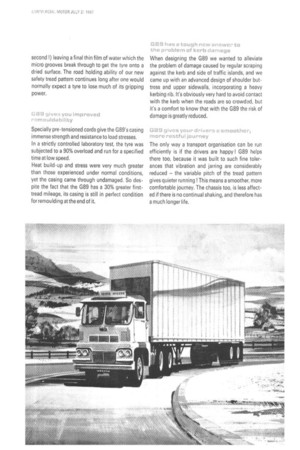GE39 can increase your first-tread mileage by as much as
Page 55

Page 56

Page 57

If you've noticed an error in this article please click here to report it so we can fix it.
a la per cent, 30 per cent. And that's from a tyre that costs no more than an ordinary tyre. A quick calculation will show you that means a 23% cut in your tyre costs. G89 puts 6% more rubber on the road than ordinary tyres, so contact pressure is reduced. We've made the tread arc flatter, too, which gives better distribution of load over the full tread-width and so reduces wear. In addition, there's a dense concentration of rubber beneath the centre section of the pattern, to give even greater resistance to wear.
And we've adopted a way of reducing the build up of heat — heat that can destroy the casing of your tyres. What we've done is to build two layers of compound into the tread. The outer one, the one in contact with the road, is very tough and wear resist
ant. Underneath it, cushioning the casing, is a softer, more resilient layer, specially formulated to keep the heat generated by the outer layer at a safe level and give the coolest running ever possible in a cross-ply tyre.
All these great advancements in tyre design were subjected to the most severe tests of speed and loading on a world-wide range of road conditions, covering over one million miles. One set of G89s, for instance, was subjected to a continuous running speed of 65 mph with a 25% overload on board the vehicle, in a temperature of 90 degrees F. Other gruelling tests were performed on testing machines in the laboratory with random samples of tyres taken from the production line. The tyre survived through conditions far above any normal working situation and the tread refused to break down.
can can slash as much as 50 per cent off your braking distances
We all know how important it is to be able to stop quickly in an emergency, particularly in the wet, so we've built into the G89 six grooves instead of the conventional four, to channel road surface water away more effectively. And we've given G89 nearly a thousand moulded slots to provide extra wiping edges to wipe the wet road surface dry and ensure maximum rubber-to-road adhesion. Together, these features give a new and much higher standard of safety on commercial vehicles. We've proved it too, by testing a 16 ton lorry fitted with G89 tyres. It pulled up in just over half the distance required on five ribbed patterns of other designs. We also found that this advantage in braking power increased with the vehicle's speed, so drivers can drive more confidently.
G89 can give you far greater corner grip—especially in the wet Another advantage in having those two extra channels on the tread pattern ! In the rain, these deep, unobstructed grooves clear most of the water away from the path of the tyre (as much as 12 pints a second !) leaving a final thin film of water which the micro grooves break through to get the tyre onto a dried surface. The road holding ability of our new safety tread pattern continues long after one would normally expect a tyre to lose much of its gripping power.
.as gives you improved '9mouldability
Specially pre-tensioned cords give the G89's casing immense strength and resistance to load stresses.
In a strictly controlled laboratory test, the tyre was subjected to a 90% overload and run for a specified time at low speed.
Heat build-up and stress were very much greater than those experienced under normal conditions, yet the casing came through undamaged. So despite the fact that the 089 has a 30% greater firsttread mileage, its casing is still in perfect condition for remoulding at the end of it. GISCS has a tough now answer to the problem of kerb damage When designing the G89 we wanted to alleviate the problem of damage caused by regular scraping against the kerb and side of traffic islands, and we came up with an advanced design of shoulder buttress and upper sidewalls, incorporating a heavy kerbing rib. It's obviously very hard to avoid contact with the kerb when the roads are so crowded, but it's a comfort to know that with the G89 the risk of damage is greatly reduced.
GI39 gives your drivers a smoother', more restful journey The only way a transport organisation can be run efficiently is if the drivers are happy G89 helps there too, because it was built to such fine tolerances that vibration and jarring are considerably reduced — the variable pitch of the tread pattern gives quieter running I This means a smoother, more comfortable journey. The chassis too, is less affected if there is no continual shaking, and therefore has a much longer life.












































































































